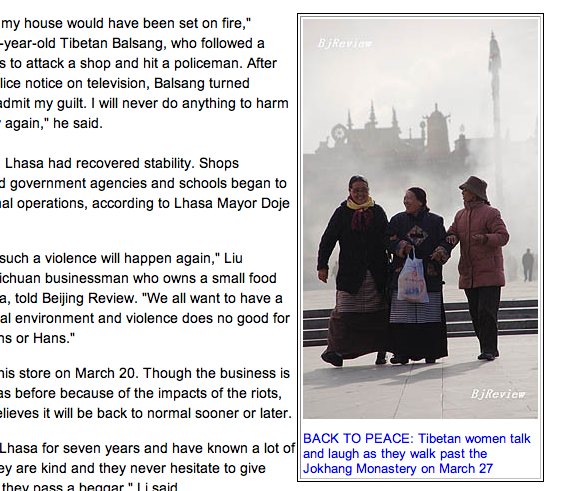China is using its press machine to counter accusations of “cultural genocide” in Tibet. China.org.cn has a Tibet portal, “Lhasa Unrest in China,” up and running to keep English-language readers abreast of the latest Tibet news.  A quick glance at the site at the time this blog post was written seems to reveal a two-pronged strategy: blame recent riots in Tibet on outside influences, i.e. the Dalai Lama clique (see Dalai Lama Clique Planning Suicide Attacks), and emphasize that inside Tibet things are returning to normal (see Restoring Faith and the picture below of the happy, smiling Tibetan women).
A quick glance at the site at the time this blog post was written seems to reveal a two-pronged strategy: blame recent riots in Tibet on outside influences, i.e. the Dalai Lama clique (see Dalai Lama Clique Planning Suicide Attacks), and emphasize that inside Tibet things are returning to normal (see Restoring Faith and the picture below of the happy, smiling Tibetan women).
In another Tibet-related article available at China.org.cn, a team of Belgians, Serge Pairoux, Secretary-General of the Belgium-China Cultural Center, and Henri Lederhandler, Vice Chairman of the Belgium-China Economic and Commercial Council, argue that Tibet was essentially always part of China and that before the communist liberation of Tibet life there for the average person was Hobbesian — nasty, brutish and short. They also blame the recent unrest in Tibet on the Dalai Lama clique, and criticize the Western media’s biased coverage of events.
Tibet has fascinated the world for centuries and inspired many romantic myths and legends. The remote mountainous region and the exotic character of Tibetan Buddhism have stirred the western imagination.
But pre-1949 Tibet was not the imagined paradise of people living a simple, happy life going about their religious activities. Society was in the grip of a type of feudal serfdom under which politics was intertwined with religion. Temples obstructed all reform; nobles ruthlessly defended their privileges and constantly intrigued against each other. In the old Tibet, serfs were traded and exchanged like pack animals. They were regarded as “horses that can talk”, not human beings.
Today the Dalai Lama is seen as a kind, attractive person; a Nobel Peace Prize laureate. But until 1949, the Dalai Lama was the speaker and representative of Tibet’s feudal system.
Under feudalism, temples and sutra schools forced families with two boys to send one of them to become a monk. Until 1951, 95 percent of Tibetans were illiterate.
The China Daily picked up the article and drew on a patchwork of other sources, including a piece from The Economist (deemed unbiased presumably), in order to bolster China’s official position on recent events in Tibet, namely that Tibet should not be independent, that the Dalai Lama clique masterminded the riots, along with some “influential US political groups,” and that the recent unrest was not merely the peaceful protesting of monks. At the end of the article the reporter cites a letter to the editor published in the South African newspaper Business Day to argue that the Dalai Lama should not be seen by Tibetans as a savior — after all Tibet was “a backward feudal region with its people enslaved” before the communists liberated it; plus the Dalai Lama has no “democratic credentials.”
For more news about the alleged planned suicide attacks on the part of Tibetan monks see this Howard French article in the IHT.
Also, Reuters is reporting today that an ethnic guerrilla group in northern Myanmar caught two “key” Tibetan political activists and deported them to China.








